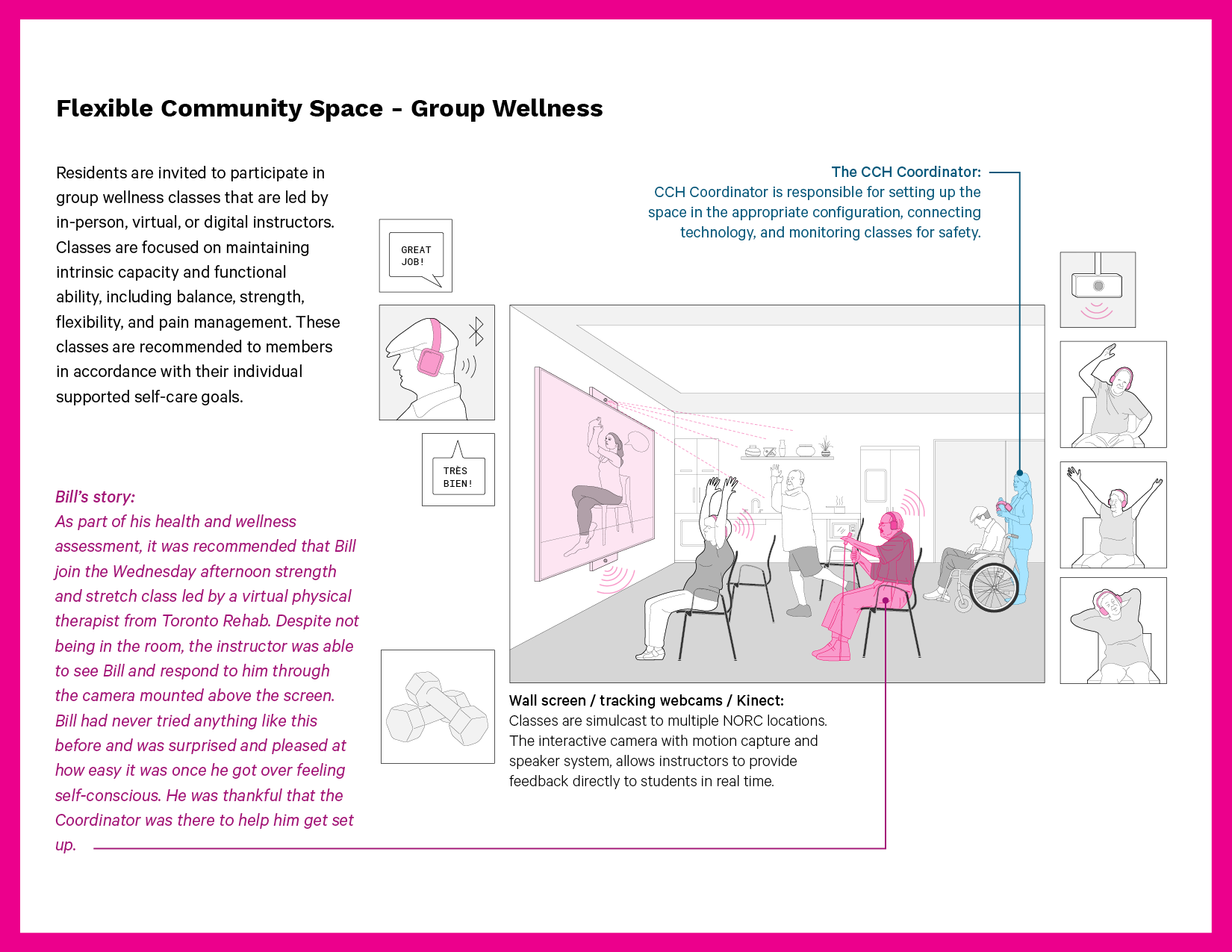Connected
Care Hub
A New Delivery Model
The ‘Connected Care Hub’ is a new service delivery model that utilizes both in-person and digital supports to help seniors age in place.
It is not a replacement for existing services, but instead represents a new, low cost solution that integrates community care with virtual care to improve quality of life, slow functional decline, and alleviate pressures on downstream institutional care.
Most importantly, the Connected Care Hub (CCH) could help keep Canada’s seniors where they want to be: aging in place.
Key Pillars of CCH
Lease of Existing Space
Retrofits commercially-available spaces in existing NORC buildings.
Incorporates a modular design approach with communal, social, and private spaces, and pays special attention towards seniors sensory and accessibility needs.
Embedded Technology Infrastructure
Enables community telemedicine and remote monitoring through plug and play technology infrastructure.
Micro-Health Sites
Creates a pathway from the health care system to patients in their own building.
Provides cost-effective, place-based care for seniors.
Supports access to care for those who face barriers due to physician retirement or challenges with travelling to medical appointments.
Supported Self-Care
Incorporates supported self-management recommendations from the World Health Organization’s Integrated Care for Older People (ICOPE) framework.
Offers support to seniors to improve health, prevent disease progression, and general decline including exercise, mobility support, nutrition, cognitive stimulation, and system navigation.
Participatory Wellness
Addresses social isolation and builds informal networks of support through active participation of residents.
Supports senior-led social and recreational programming which builds meaning, mattering, and sense of value.
How Could This Be Supported?
Several sustainability models emerged through stakeholder interviews and co-design sessions. One example considers the possibility of a geographically proximate group practice, such as a Family Health Team (FHT) or Community Health Centre (CHC), attaching itself to a NORC building or group of NORC buildings and developing a virtual care offering.
The enhanced technology infrastructure at the CCH and facilitated support on the ground would expand clinicians scope of practice during virtual visits and increase access to appropriate levels of care.
In Ontario, this prospect appears tailor-made for the new Ontario Health Team (OHT) mandate, which has a directive to integrate services for high-needs populations within a geographic catchment. Seniors are a primary group to target, with NORC buildings and the Connected Care Hub being a model that considers the future of care given trends in urbanization, population growth, and technological innovation.
Benefits
Accessibility: improving seniors’ ability to access support in their own building has the potential to prevent early decline, and preserve physical and mental capacity.
Reduces strain on long-term care system: reaching seniors on the low risk scale early can reduce critical incidents and delay entry into long-term care.
Adoption of virtual care: onsite communal equipment enhances scope of practice and allows primary care providers to deliver the same standard of care as in-person visits; Support from a CCH coordinator on the ground will help seniors use new technologies and improve efficiency during appointments.
Cost savings: CCH model makes use of the existing stock of residential buildings – where seniors pay their own rent, food, and utilities – instead of investing in the construction of new builds.
Home and Community Care Re-imagined: expanding virtual care into NORC buildings could help prevent avoidable 911 calls, emergency department transfers, and hospital stays.
Aging in Place: provides an elegant mechanism to support hundreds of seniors who live under the same roof, and keeps them where they want to be: at home.
follow us on twitter
OpenLab@uhn.ca
uhnOpenLab.ca
Vertical Aging Editorial
The Digital Neighbour Network
The Connected Care Hub
Social Spaces



















